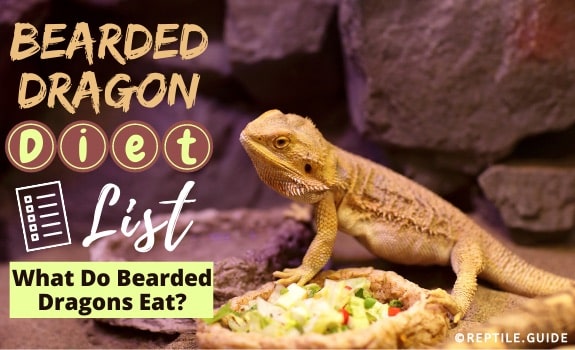Learning about a nutritious AND healthy bearded dragon diet is FUNDAMENTAL to their long term health.
Luckily, regardless of whether you’ve adopted an 8-week old baby bearded dragon or a senior bearded dragon, this article will provide excellent insight on what foods your bearded dragon should be fed PLUS when you should be feeding them.
Here Are The Questions This Article Will Answer…
- What Do Bearded Dragons Eat? (foods for every age)
- How Much Food Should I Be Feeding?
- How Often Bearded Dragons Should Be Fed? (bearded dragon feeding schedule)
- What Does A Baby Bearded Dragon Diet Look Like?
- What Vegetables Can Bearded Dragons Eat?
- What Fruits Can Bearded Dragons Eat?
- What Insects Can Bearded Dragons Eat?
- & Many More Food Related Questions!
You see, age with bearded dragons is everything when it comes to food. And as you’ll soon learn, cage temperatures aren’t the only thing that should be adjusted as your precocious little baby beardie transitions into adulthood…
Understanding what foods bearded dragons eat will not only keep them healthy, but also help to prevent serious health problems down the line… some of which are IRREVERSIBLE, PAINFUL, and downright COSTLY to treat.
The bottom line?
Feeding your bearded dragon the RIGHT foods and maintaining a proper diet from an early age will help ensure they not only have plenty of years in life, but more importantly, plenty of life in their years!
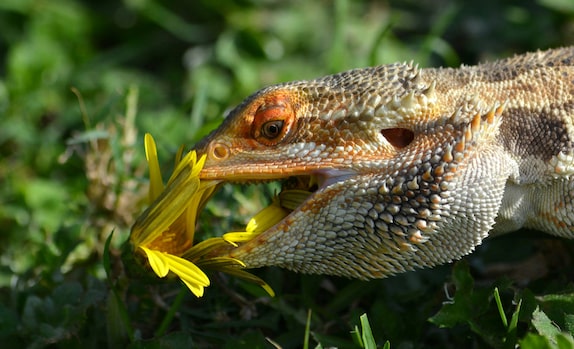
Above all else, the number one question I get asked by new and prospective bearded dragon owners is…
“What do bearded dragons eat?”
As such, I’ve gone ahead and provided basically a master list of EVERY food (fruits, greens, vegetables, and live insects) that bearded dragons eat and that you should be feeding them.
And should you already know what foods you should be feeding? Well, just feel free to skip over this section and jump straight into the actual feeding recommendations per age in the next section.
In This Article
What Fruits Can Bearded Dragons Eat?
Although nowhere near as much of a staple food in a beardie’s diet as vegetables, a little bit of fruit certainly can help liven things up!
As such, it’s great to know what fruits can bearded dragons eat for those instances in which you want to offer them treats.
Also consider feeding fruit to help develop your beardie’s palette and make salads more inviting as this tends to be a food group they love!
What Fruits Can Bearded Dragons Eat? Any Of The Following…
- Peeled apples
- Cherries (without the pit)
- Blueberries, Blackberries, strawberries, cranberries
- Figs
- Green & Red Grapes
- Guava
- Honeydew & Cantaloupe
- Apricot
- Canned pineapple and prunes
- Watermelon
- Seedless Raisins
- Papaya
- Peach
- Pears
- Mandarin Oranges
- Mango
- Plums
What Vegetables Can Bearded Dragons Eat?
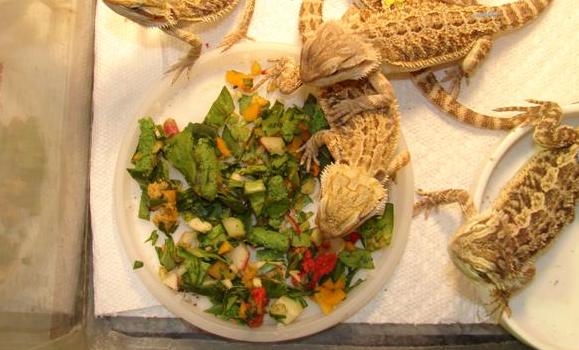
Greens and vegetables are the ONE food bearded dragons should be fed as much as they want!
However, bearded dragons cannot eat every vegetable! As such, you’ll want to learn what vegetables can bearded dragons eat to avoid poisoning them or giving them diarrhea.
What Vegetables Can Bearded Dragons Eat? Any Of The Following…
- Collard Greens
- Dandelion Greens
- Turnip Greens
- Mustard Greens
- Artichoke Heart (uncooked)
- Arugula
- Asparagus
- Basil
- Bell Pepper (Green, Red, Yellow)
- Bok Choy
- Red & Green Cabbage
- Peeled Cucumber
- Squash (Acorn, Butternut, Spaghetti, & Summer)
- Uncooked Kale, Radish, Pumpkin, Zucchini, & Leeks
- Okra
- Parsnip
What Insects Can Bearded Dragons Eat?
It should probably go without saying, but I’ll say it anyways…
Bearded dragons NEVER should be fed any insects you’ve caught. By feeding your beardie these insects, you are seriously risking their health.
Only buy insects from REPUTABLE and TRUSTWORTHY sellers as bugs caught outside often have pesticides and other chemicals on them that can poison your bearded dragon.
Also, please note that not all of the insects below will be great choices for a young or baby bearded dragon. To understand which ones are, just jump down farther and read about their specific dietary needs.
Insects Bearded Dragons Eat:
- Crickets
- Dubia Roaches
- Super Worms
- Silk Worms
- Butterworms
- Black Soldier Fly Larvae (Phoenix Worms)
- Earthworms
- Wax Worms
- Goliath Worms (larvae of the Carolina Sphinx Moth)
- Mealworms
- Locusts
- Redworms
Bearded Dragon Diet in the Wild
Now, with SO many options for what you should be feeding your bearded dragon you may find yourself wondering what foods they eat in the wild!
I mean, it’s not like they’re able to switch between collard greens and mustard greens, let alone find them for that matter!
In the wild, bearded dragons mostly eat small insects like spiders, termites, and crickets. Believed to be seasonally savvy foragers, bearded dragons will also forage for flowers and leafy greens where they can find them.
The primary difference between a bearded dragon’s diet in the wild and captivity is that wild bearded dragons are feeding on A LOT more protein than they do in captivity.
Having to roam around everyday burns way more calories and as such, they need the extra protein to ensure they have enough energy.
If you began feeding a bearded dragon in captivity as much protein as a bearded dragon in the wild is accustomed to eating… they would likely become overweight and suffer from serious health issues.
Baby Bearded Dragon Diet
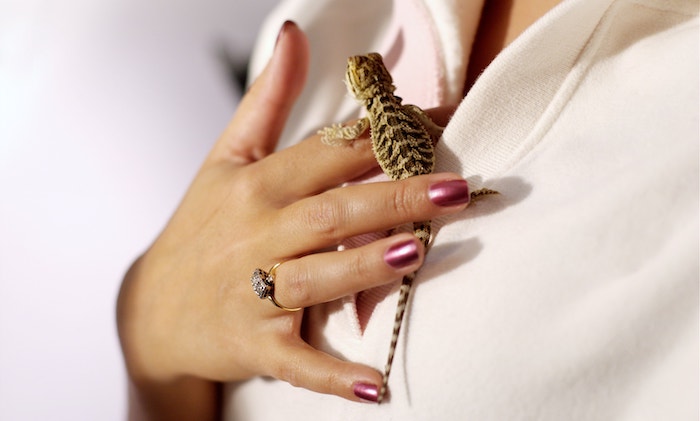
So, now that you have an idea of what bearded dragons eat, let’s jump directly into discussing what you should IDEALLY be feeding a baby bearded dragon.
In this instance, we will be discussing the baby bearded dragon diet for bearded dragons age 0-4 months of age.
Some people will consider a bearded dragon at 2 months of age a “juvenile”, BUT in my experience I find it beneficial to continue feeding the baby bearded dragon diet until 4 months of age. I find that this really gives your bearded dragon an advantage with their development.
Of course, you should feel free to implement the juvenile bearded dragon diet at 3 months if you like. It’s really up to you and what you think is right when it comes to feeding YOUR beardie!
Feeders for a Baby Bearded Dragon
As you probably know by now, baby bearded dragon foods are rich in protein. This will naturally mean your bearded dragon should be eating an abundance of live feeders.
How Often You Should Be Feeding Your Baby Bearded Dragon:
- For a bearded dragons 0-2 months, you should be feeding them eat as many crickets as possible in a 5-10 minute time frame 4-5 times per day.
- For bearded dragons 3-4 months, let them eat as many crickets as they want 3-4 times a day in a 5-10 minute time frame.
Greens & Vegetables for a Baby Bearded Dragon
Think it’s just about the protein for your little dragon in training? Think again!
Baby bearded dragons still need greens and vegetables in their diet, just not nearly as much as older beardies.
Aim for a diet break down of 80% feeders and 20% vegetables for your baby. Also, make sure to remove whatever food ISN’T eaten within around 30 minutes, be it feeders of vegetables.
Calcium & Vitamins for a Baby Bearded Dragon
Because this period of time is crucial for your little baby, dust their feeders with a calcium/D3 supplement once a day for 5 days a week, but NEVER twice a day. On the 2 days a week they don’t receive this supplement, douse their feeders with their multi vitamin.
Basically, they should be having their feeders doused in something once a day, every day.
Juvenile Bearded Dragon Diet
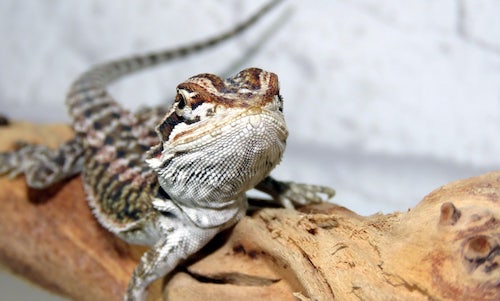
For a juvenile bearded dragon, we are going to be talking about beardies between the ages of 5 and 17 months.
However, with this being said, I am going to make some adjustments in regard to the food you should be feeding juveniles once they reach 12 months of age, so pay special attention to the information provided below.
Feeders for a Juvenile Bearded Dragon
Taking things down a notch now that your baby is a little older, I recommend feeding your juvenile bearded dragon as many crickets as they can eat 2-3 times a day for 5-10 minute intervals until they reach 9 months of age.
From 9 months -12 months of age, feed them as many crickets as they can eat in 5-10 minutes just 2 times per day.
Once your bearded dragon is 12 months of age, start slowly feeding them their adult diet. This will consist of you slowly changing the proportion of feeders to vegetables and greens. Try to stop letting them eat as many feeders as they can and instead give them a set amount twice daily.
For example, if your beardie is used to eating 20 feeders twice daily for a total of 40 crickets, try giving them 15 crickets twice a day and instead supplementing with more vegetables.
You’ll want to slowly wean the number of crickets down over the course of a couple months as you raise their vegetable intake.
After 3-5 months, their diet should be pretty close to that of the adult diet discussed in the next section…
What If You Want to Feed Your Juvenile Other Feeders Besides Crickets?
If you’re looking to give your juvenile beardie a premium source of protein, check out my recommendations below!
*Please note, I recommend you still give your beardie his salad daily, regardless of the feeder schedule!
Juveniles 4-9 months
- 40-50 smaller nymph (0.5”) Dubias per day
- 8-12 super worms once a day
- 50-100 phoenix worms per day
Juveniles 9 Months+
- 10-20 nymph Dubias per day (1”)
- 5-7 super worms every other day
- 50-75 phoenix worms per day
Greens & Vegetables for a Juvenile Bearded Dragon
As mentioned above, this is the time period where your bearded dragon should start exploring more adult foods, specifically greens and vegetables.
Feel free to follow the 80/20 rule if you like until your beardie is about 9 months old.
At this point, I would really recommend that you start incorporating more greens and vegetables in their diet and also allowing them to try different types as well. Variety is key!
Once your bearded dragon is 12 months of age, they will ideally be getting ready to have a diet that is roughly 50-50 between feeders and greens. As the continue on toward maturation at 18 months, the green intake will raise to eventually be around 80%, whereas the feeder intake will lower to be about 20%.
If you can accomplish this by the time they’re 13 months, consider yourself a pro! If not, don’t worry too much.
Some bearded dragons adjust to more easily with greens than others who are more picky with food. Plus, as I mentioned above, variety is key so what you give them does matter…
Calcium & Vitamins for a Juvenile Bearded Dragon
Keep the rate at which your bearded dragon receives calcium/D3 and a multi vitamin the same until they reach 12 months of age.
From this point on, lower the calcium/D3 to just 3 times a week (no more than once per day) and the multivitamin to one time per week.
Once your dragon is 18 months of age, you can lower the calcium/D3 to just twice weekly if you like. But three times is still fine as well.
Adult Bearded Dragon Diet
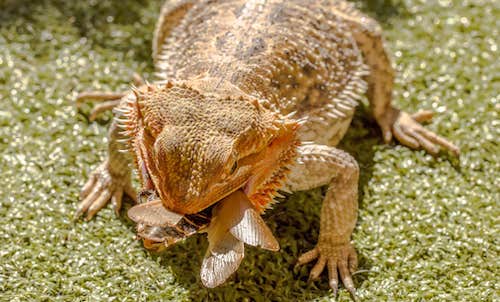
Now, let’s discuss what you should be feeding an adult bearded dragon for optimal health. If you’ve read the sections above, then you know an adult bearded dragon is one that is at least 18 months of age.
It is at this age, that the bearded dragon has not only stopped growing, but has also reached peak sexual maturity. As such, the diet discussed below will be appropriate to feed your dragon for the rest of his or her life.
The ONLY exception to this will naturally be if your dragon is sick, post-op, or experiencing some other type of circumstantial health issue. In these instances, you will naturally want to adjust the diet to better fit your beardie’s needs at that time.
Feeders for An Adult Bearded Dragon
Now, because your bearded dragon still needs a staple source of protein, you will need to provide them with insects.
However, unlike their younger counterparts, they will NOT need to eat nearly as many insects since they are no longer growing.
The only time you will likely want to give them an abundance of protein will be if they need to gain weight.
How many feeders your bearded dragon needs will in part depend on their size. Some adult bearded dragons who are quite large can eat twice as many crickets a week as smaller adult beardies, without becoming overweight.
As such, the suggestions below are just that and nothing more. This means, you may need to adjust them a little depending on your beardie’s size.
- 10 crickets per day OR 20 crickets every other day
- 3-5 large Dubias (2”) or 5-9 nymph Dubia (1”)
- 7-10 super worms every other day
- 5-20 phoenix worms per day (in addition to another feeder)
In regard to the Phoenix worms, I’ve only recommended 5-20 per day because these are VERY expensive feeders. You can use them as a supplement or a treat because of this. Also, they DON’T need to be dusted with calcium since they are chock full of it.
Greens & Vegetables for an Adult Bearded Dragon
Adult bearded dragons will do well on a diet that consists of 80% greens and vegetables. Because of this, you’re going to want to give them a fresh salad EVERY. SINGLE. DAY.
Once again, if your bearded dragon ISN’T enthusiastic about their greens, try mixing it up a little using the list at the beginning of this article.
Calcium & Vitamins for an Adult Bearded Dragon
Once your bearded dragon is an adult, you can go down to calcium/D3 just 2-3 times per week and a multi vitamin once per week. Just make sure their food NEVER gets dusted more than once per day.
Bearded Dragon Feeding Schedule
How often you feed your bearded dragon is going to pretty much depend on their age.
As such, you’ll have to adopt a new bearded dragon feeding schedule several times throughout your pet’s lifespan.
However, one thing that WON’T change? The fact that you’ll need to turn the lights on a good 30-60 minutes before feeding AND leave them on for just as long after feeding.
If your beardie doesn’t warm themselves up, they may not have a strong enough appetite to eat.
Furthermore, they also won’t be able to properly absorb the nutrients their body needs, specially the D3 in calcium. In this instance, whatever you feed them will in essence just be a waste.
You’ll also want to make sure you remove any and all food that isn’t eaten within 30 minutes or less.
Bearded dragons are NOT grazers, so if food is still there after some time has passed, they don’t want it.
The last thing you want is feeders left behind to harass and bite your bearded dragon because believe it or not, they totally will.
Lastly, you also want to eliminate any left behind veg or fruit as this can go sour and grow bacteria.
Adult Bearded Dragon Feeding Schedule
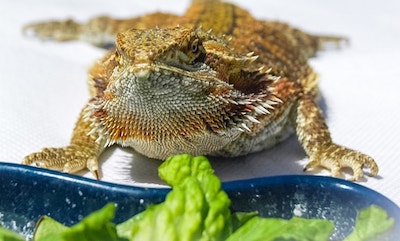
For adults, I recommend feeding them half their food in the morning and then the other half at night. Now, if this isn’t possible for you or too big of an inconvenience you can always feed them all their food just once a day as well.
In this instance, I recommend you be a little slower to remove their salad since they’ll have to wait a whole 24 hours to get more food.
Baby Bearded Dragon Feeding Schedule
For babies 0-2 months, give them as many crickets as they can consume in a 5-10 minute periods 4-5 times daily. Your baby should be consuming between 30 and 60 crickets a day, give or take some.
For babies 3-4 months, go down to feedings 3-4 times a day, still allowing them to consume as much as they want in 5-10 minute windows.
You’ll want to continue this until about 8 or 9 months, at which point you’ll get your bearded dragon their adult feeding schedule of meals twice a day.
However, bearded dragons at this age should be fed extra protein and allowed to indulge as they will continue growing for the next 7-10 months.
If you feel like your bearded dragon is slowing down in growth, you can be all means adjust the diet to just a staple amount of feeders per day as well.
This is also when you’ll want to start incorporating more greens too, which once again, you can give as often as they’ll eat them.
Bearded Dragon Diet By Age
It’s probably pretty clear by now, but I’ll state it again for good measure…
The primary difference between a young and old bearded dragon’s diet is that…
The younger beardie should be fed a significantly higher amount of protein, while the older/adult beardie should be eating primarily vegetables and greens.
Young bearded dragons need a high volume of protein to ensure they develop appropriately and grow up to be big and strong.
On the flip side, older bearded dragons who consume too much protein will simply become fat and can even develop health problems.
Adult bearded dragons simply do NOT need the protein that younger dragons do. This is why you’ll read that an adequate bearded dragon diet consists of 80% greens and veggies, and only 20% protein.
Lastly, I should probably mention that by “adult”, I’m referring to dragons around the age of 18 months as this is when they reach sexual maturity.
A bearded dragon is still considered a juvenile at 12 months of age because they are still growing and developing.
How to Transition a Bearded Dragon to a New Diet
Now that you have an idea of WHEN and WHY to change up your bearded dragon’s diet, let’s talk about how to actually transition them into this change.
Bearded dragons can be picky eaters who can become downright grumpy when forced to eat foods they don’t like (like a new vegetable).
They can even outright shun the vegetables in their salads like a petulant child! Because of this, you’ll want to make sure you really ease them into eating new foods.
Also, mix it up with the vegetables and even throw in a little fruit here and there!
You’ll never know what foods your bearded dragon will lose their mind over until you experiment a little.
You should also be fully aware that once you introduce the good stuff, like Super Worms and Dubia Roaches, they may never quite look at crickets the same way again!
Now, chances are your bearded dragon may put up a serious fight when it comes to eating their vegetables. But, if after trying a variety of different foods they still seem reluctant to eating healthy, fear not…
What NOT to Feed Your Bearded Dragon
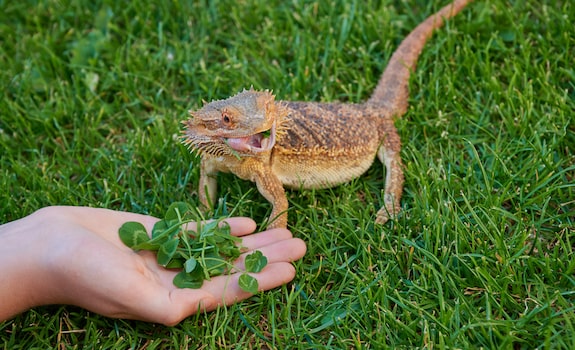
Now that you have a pretty good idea of what you should be feeding your bearded dragon, let’s talk about what foods you should NOT feed them!
NEVER bearded dragon any of the following foods:
- Dairy products (cheese, ice cream, milk, etc.)
- Avocado
- Lettuce
- Fireflies
- Rhubarb
- Beets tops
- Spinach
- Meat (red meat, poultry, etc.)
- Wild caught insects
- Fish & seafood
- Fern
- Buttercup
- Daffodil
- Bran & Wheat
A good rule of thumb is… if you DON’T know whether the food is approved for sure or not, just don’t give it to your bearded dragon!
Wrapping Up
It is my hope that you have found this article to be insightful in teaching you not only exactly what you should be feeding your bearded dragon, but also when they should be fed and what foods NOT to feed them.
As a former first-time bearded dragon owner myself, I know how confusing it can be to figure out how much to feed your baby, especially as they continue to grow and get older!
I also know how frustrating it can be to go and buy special produce or other foods for your bearded dragon thinking that they’re going to love it, only to discover they want nothing to do with it.
I’ll never forget taking the time to peel organic cucumber for my beardie only to see her totally rebuke it! Sad face.
But, rest assured that finding a staple diet your bearded dragon LOVES may just take a little time and patience on your end.
After enough effort you will surely find what food makes your bearded dragon happy.
Now that you know what bearded dragons eat, perhaps you’d like to learn more about other animals’ fascinating diets.
For example, you could find out what axolotls eat! And who knows? You might decide to pick up a new axolotl pet afterwards.
